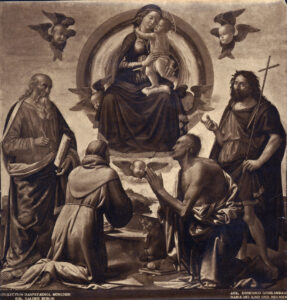Poulenc, Gloria

When I last featured Poulenc just a few weeks ago, I mentioned my plan to turn to a larger scale work by Poulenc in the near future. I addressed Poulenc’s ability to express serious musical ideas with an unaffected simplicity.
Francis Poulenc (1899-1963) had been raised in a family of devout Catholics in southern France. But his young adulthood was spent in the very secular musical scene in Paris with Les Six, and his early works tend to be lighthearted and even irreverent. His biographers emphasize the impact on Poulenc of his close friend dying in a car accident in 1936 and his re-embrace of the Catholic faith. Poulenc would then turn to sacred music: Litanies à la vierge noir (1936) and Mass in G (1937). Later would comes his opera Dialogues of the Carmelites (1957) on the execution of Carmelite nuns during the French Revolution, his Sept répons des ténèbres (1961), and Gloria (1959).
Poulenc now tends to be regarded, along with Olivier Messaien, as perhaps the most notable composer of French sacred music in the 20th century. We will get to Messaien at some point, but I think it’s worth comparing the Gloria to Fauré’s Requiem (Performance Pick 294). Poulenc was apparently not a fan of Fauré. Fauré scholar Jean-Michel Nectoux says Poulenc’s aversion seems strange because of all the members of Les Six, Poulenc “is the nearest to Fauré in the limpid clarity and singing quality of his own writing, in his charm.”
While I tend to agree with this assessment and think some of things we said about Fauré’s Requiem could also apply to the Poulenc Gloria, on the surface the two works seem quite different. Of course, a Gloria and a Requiem serve very different ends. But Poulenc is not restrained. His melodies are often angular and they soar. The mood swings widely: light, exuberant, sombre. But like the Fauré Requiem, the Gloria has immediate appeal.



